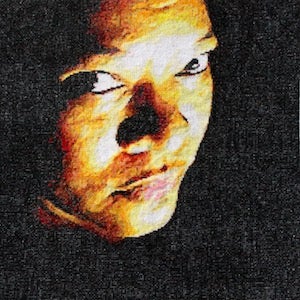This article was published in Scientific American’s former blog network and reflects the views of the author, not necessarily those of Scientific American
In this episode of our podcast My Favorite Theorem, my cohost Kevin Knudson and I enjoyed talking with Chawne Kimber, a math professor at Lafayette College in Pennsylvania. You can listen to the episode here or at kpknudson.com, where there is also a transcript.

"Girl with the side eye," a self-portrait by Chawne Kimber. Credit: Chawne Kimber
On supporting science journalism
If you're enjoying this article, consider supporting our award-winning journalism by subscribing. By purchasing a subscription you are helping to ensure the future of impactful stories about the discoveries and ideas shaping our world today.
For the podcast, Dr. Kimber decided to talk about a favorite suite of theorems rather than just one. The theorem that started it all is the Hahn embedding theorem. Proved in the early 1900s, this theorem says that each group satisfying certain general conditions can be thought of as a subset of products of the real numbers. As she described, this theorem means we can think of these groups as ways of “hacking at the real numbers.” The rest of her favorite theorems are in the spirit of the Hahn embedding theorem, changing the assumptions in various ways and yielding related results. These theorems often tie algebra and topology together in interesting and sometimes surprising ways. For more detailed information on these theorems (accessible to mathematicians), you can look at work of Rodney Downey and Reed Solomon, Daniel Gluschankof, and Philip Ehrlich.
Dr. Kimber talked about the relationship between her favorite theorems and the axiom of choice. This axiom, which most mathematicians use in their work, says that one can choose a single element of every set in a collection of nonempty sets. That sounds incredibly easy to do: pick something, anything! There’s no problem with doing that when you have a finite number of sets, each of which contains a finite element. But as with so many things in mathematics, it gets weird when infinity gets involved. If there are an infinite number of elements in each set—in particular, if there are uncountably many—how can you decide on just one of them? With some sets, there might be an easy answer, like “choose the smallest number,” but how could one choose the smallest number strictly greater than 0 and less than 1? What if the set doesn’t come in one convenient piece like the interval between 0 and 1 and it’s a collection of points scattered randomly about the real axis? One important conjecture in Dr. Kimber’s field is that the Hahn embedding theorem is equivalent to the axiom of choice, making it one of many, many equivalent statements.
In each episode of the podcast, we ask our guest to pair their theorem (or theorems, in this case) with something—food, beverage, art, music, or any other delight in life. Dr. Kimber’s pairing is a tribute to her Ph.D. advisor Jorge Martinez, a lover of both wine and opera. So she recommends enjoying the Hahn theorem and its relatives with a glass of good chianti and Mozart’s opera Così fan tutte.

One of Dr. Kimber's quilts. Credit: Chawne Kimber
In addition to professing mathematics, Dr. Kimber is an accomplished quilter, and we talked about how she started quilting and the pressure she felt as a black woman on the tenure track. Her quilting is part of her activism, and many of her quilts feature four-letter words (“the more interesting four-letter words,” as she puts it) and political messages.
You can find Dr. Kimber at her website and her blog completely cauchy. If you’d like to see her quilts in person, you have a few opportunities now and in the near future:
Responses to Gee’s Bend, List Gallery, Swarthmore College, Swarthmore, PA, Sept-Oct 2018
The Migrant’s Alphabet, City Lights Gallery, Bridgeport, CT, Oct 2018
Shine Bright, The Quilter’s Hall of Fame, Marion, Indiana, Oct-Dec, 2018
Quilts=Art=Quilts, Schweinfurth Art Center, Auburn, NY, Oct, 2018-Jan 2019
Crafting Democracy: Fiber Arts and Activism, Harold Hacker Hall, Central Library of Rochester (New York) & Monroe County, Aug-Oct 2019
You can find more information about the mathematicians and theorems featured in this podcast, along with other delightful mathematical treats, at kpknudson.com and here at Roots of Unity. A transcript is available here. You can subscribe to and review the podcast on iTunes and other podcast delivery systems. We love to hear from our listeners, so please drop us a line at myfavoritetheorem@gmail.com. Kevin Knudson’s handle on Twitter is @niveknosdunk, and mine is @evelynjlamb. The show itself also has a Twitter feed: @myfavethm and a Facebook page. Join us next time to learn another fascinating piece of mathematics.
Previously on My Favorite Theorem:
Episode 0: Your hosts' favorite theorems Episode 1: Amie Wilkinson’s favorite theorem Episode 2: Dave Richeson's favorite theorem Episode 3: Emille Davie Lawrence's favorite theorem Episode 4: Jordan Ellenberg's favorite theorem Episode 5: Dusa McDuff's favorite theorem Episode 6: Eriko Hironaka's favorite theorem Episode 7: Henry Fowler's favorite theorem Episode 8: Justin Curry's favorite theorem Episode 9: Ami Radunskaya's favorite theorem Episode 10: Mohamed Omar's favorite theorem Episode 11: Jeanne Clelland's favorite theorem Episode 12: Candice Price's favorite theorem Episode 13: Patrick Honner's favorite theorem Episode 14: Laura Taalman's favorite theorem Episode 15: Federico Ardila's favorite theorem Episode 16: Jayadev Athreya's favorite theorem Episode 17: Nalini Joshi's favorite theorem Episode 18: John Urschel's favorite theorem Episode 19: Emily Riehl's favorite theorem Episode 20: Francis Su's favorite theorem Episode 21: Jana Rordiguez Hertz's favorite theorem Episode 22: Ken Ribet's favorite theorem Episode 23: Ingrid Daubechies's favorite theorem Episode 24: Vidit Nanda's favorite theorem Episode 25: Holly Krieger's favorite theorem Episode 26: Erika Camacho's favorite theorem Episode 27: James Tanton's favorite theorem
